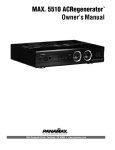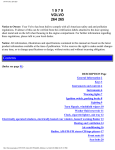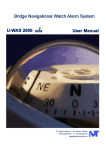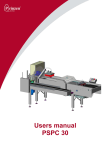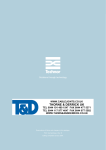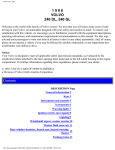Download DieHard Portable Power 950 Operator`s manual
Transcript
OPERATOR’S MANUAL Portable Power 950 Model No. 28.71987 Read and follow all Safety Rules and Operating Instructions before Every Use of this Product. Save these instructions. Sears Brands Management Corporation, Hoffman Estates, IL 60179 U.S.A. 00-99-001001/0710 Table of Contents Section Page IMPORTANT SAFETY INSTRUCTIONS 2 PERSONAL PRECAUTIONS 3 FOLLOW THESE STEPS WHEN connecting to a BATTERY 4 Grounding and AC power cord connections 5 ASSEMBLY INSTRUCTIONS 5 FEATURES 5 Charging the internal battery of the Jump starter 6 OPERATING INSTRUCTIONS 6 MAINTENANCE INSTRUCTIONS 8 Moving and STORAGE INSTRUCTIONS 8 TROUBLESHOOTING 9 SPECIFICATIONS 10 REPLACEMENT PARTS/accessories 10 CONTAINS SEALED NON-SPILLABLE LEAD-ACID BATTERY. MUST BE DISPOSED OF PROPERLY. WARNING: Possible explosion hazard. Contact with battery acid may cause severe burns and blindness. Keep out of reach of children. DieHard ONE-Year Full Warranty When operated and maintained according to all supplied instructions, if this DieHard product fails due to a defect in material or workmanship within 1 year from the date of purchase, return it to any DieHard outlet in the United States for free replacement. This warranty gives you specific legal rights, and you may also have other rights which vary from state to state. Sears Brands Management Corporation, Hoffman Estates, IL 60179 For customer assistance or replacement parts, call toll-free from 7 am to 5 pm CT Monday through Friday: 1-800-732-7764 IMPORTANT: READ AND SAVE THIS SAFETY AND INSTRUCTION MANUAL. SAVE THESE INSTRUCTIONS – Charge the jump starter internal battery immediately after purchase, after every use and every 30 days. This manual will show you how to use your jump starter safely and effectively. Please read, understand and follow these instructions and precautions carefully, as this manual contains important safety and operating instructions. The safety messages used throughout this manual contain a signal word, a message and an icon. The signal word indicates the level of the hazard in a situation. Indicates an imminently hazardous situation which, if not avoided, will result in death or serious injury to the operator or bystanders. Indicates a potentially hazardous situation which, if not avoided, could result in death or serious injury to the operator or bystanders. Indicates a potentially hazardous situation which, if not avoided, could result in moderate or minor injury to the operator or bystanders. Indicates a potentially hazardous situation which, if not avoided, could result in damage to the equipment or vehicle or property damage. Safety messages in this manual contain two different type styles. • Unnumbered type states the hazard. • Numbered type states how to avoid the hazard. The icon gives a graphical description of the potential hazard. Pursuant to California Proposition 65, this product contains chemicals known to the State of California to cause cancer and birth defects or other reproductive harm. •1• 1. IMPORTANT SAFETY INSTRUCTIONS - SAVE THESE INSTRUCTIONS This manual contains important safety and operating instructions RISK OF ELECTRIC SHOCK OR FIRE. 1.1 1.2 1.3 Read the entire manual before using this product. Failure to do so could result in serious injury or death. Keep out of reach of children. Use only recommended attachments. Use of an attachment not recommended or sold by the jump starter manufacturer may result in a risk of fire, electric shock or injury to persons or damage to property. 1.4 Do not put fingers or hands into any of the jump starter’s outlets. 1.5 1.6 Do not expose the jump starter to rain or snow. To reduce the risk of electric shock, turn off and/or unplug the jump starter before attempting any maintenance or cleaning. Simply turning off the controls will not reduce this risk. 1.7 Do not operate the jump starter if it has received a sharp blow, been dropped or otherwise damaged in any way; take it to a qualified service person. (Call customer service at: 1-800-732-7764.) 1.8 Do not disassemble the jump starter; take it to a qualified service person when service or repair is required. Incorrect reassembly may result in a risk of fire or electric shock. (Call customer service at: 1-800-732-7764.) RISK OF EXPLOSIVE GASES. 1.9 WORKING IN THE VICINITY OF A LEAD-ACID BATTERY IS DANGEROUS. BATTERIES GENERATE EXPLOSIVE GASES DURING NORMAL BATTERY OPERATION. FOR THIS REASON, IT IS OF UTMOST IMPORTANCE THAT YOU FOLLOW THE INSTRUCTIONS EACH TIME YOU USE THE jump starter. 1.10 To reduce the risk of a battery explosion, follow these instructions and those published by the battery manufacturer and the manufacturer of any equipment you intend to use in the vicinity of the battery. Review the cautionary markings on these products and on the engine. •2• 2. PERSONAL PRECAUTIONS RISK OF EXPLOSIVE GASES. A SPARK NEAR THE BATTERY MAY CAUSE A BATTERY EXPLOSION. TO REDUCE THE RISK OF A SPARK NEAR THE BATTERY: 2.1 2.2 2.3 2.4 2.5 2.6 2.7 2.8 Working in the vicinity of a lead-acid battery is dangerous. Batteries generate explosive gases during normal battery operation. For this reason, it is of utmost importance that you follow the instructions each time you use the jump starter. NEVER smoke or allow a spark or flame in the vicinity of a battery or engine. Do not permit the internal battery of the jump starter to freeze. Never charge a frozen battery. To prevent sparking, NEVER allow clips to touch together or contact the same piece of metal. When charging the internal battery of the jump starter, work in a well ventilated area and do not restrict the ventilation in any way. Be extra cautious to reduce the risk of dropping a metal tool onto a battery. It might spark or short-circuit the battery or other electrical part that may cause an explosion. Remove personal metal items such as rings, bracelets, necklaces and watches when working with a lead-acid battery. A lead-acid battery can produce a shortcircuit current high enough to weld a ring or the like to metal, causing a severe burn. Be sure the area around the battery is well ventilated while the jump starter is being used. RISK OF CONTACT WITH BATTERY ACID. BATTERY ACID IS A HIGHLY CORROSIVE SULFURIC ACID. 2.9 2.10 2.11 2.12 2.13 2.14 2.15 2.16 2.17 Consider having someone close enough by to come to your aid when you work near a lead-acid battery. Have plenty of fresh water and soap nearby in case battery acid contacts your skin, clothing or eyes. Wear complete eye and body protection, including safety goggles and protective clothing. Avoid touching your eyes while working near the battery. If battery acid contacts your skin or clothing, immediately wash the area with soap and water. If acid enters your eye, immediately flood the eye with cold running water for at least 10 minutes and get medical attention right away. If battery acid is accidentally swallowed, drink milk, the whites of eggs or water. DO NOT induce vomiting. Seek medical attention immediately. Stay clear of fan blades, belts, pulleys and other parts that may cause injury. Clean the battery terminals before using the jump starter. During cleaning, keep airborne corrosion from coming into contact with your eyes, nose and mouth. Use baking soda and water to neutralize the battery acid and help eliminate airborne corrosion. Do not touch your eyes, nose or mouth. Determine the voltage of the battery by referring to the vehicle owner’s manual and make sure that the output voltage of the jump starter is correct. Make sure that the jump starter cable clips make tight connections. •3• 3. FOLLOW THESE STEPS WHEN connecting to a BATTERY A SPARK NEAR THE BATTERY MAY CAUSE A BATTERY EXPLOSION. TO REDUCE THE RISK OF A SPARK NEAR THE BATTERY: NEGATIVE GROUNDED SYSTEM 3.1 3.2 3.3 3.4 3.5 3.6 3.7 3.8 Attach the output cables to the battery and chassis as indicated below. Never allow the output clips to touch each other. Position the DC cables to reduce the risk of damage by the hood, door and moving or hot engine parts. NOTE: If it is necessary to close the hood during the charging process, ensure that the hood does not touch the metal part of the battery clips or cut the insulation of the cables. Stay clear of fan blades, belts, pulleys and other parts that can cause injury. Check the polarity of the battery posts. The POSITIVE (POS, P, +) battery post usually has a larger diameter then the NEGATIVE (NEG, N, -) post. Determine which post of the battery is grounded (connected) to the chassis. If the negative post is grounded to the chassis (as in most vehicles), see step 3.6. If the positive post is grounded to the chassis, see step 3.7. For a negative-grounded vehicle, connect the POSITIVE (RED) clip from the jump starter to the POSITIVE (POS, P, +) ungrounded post of the battery. Connect the NEGATIVE (BLACK) clip to the vehicle chassis or engine block away from the battery. Do not connect the clip to the carburetor, fuel lines or sheet-metal body parts. Connect to a heavy gauge metal part of the frame or engine block. For a positive-grounded vehicle, connect the NEGATIVE (BLACK) clip from the jump starter to the NEGATIVE (NEG, N, -) ungrounded post of the battery. Connect the POSITIVE (RED) clip to the vehicle chassis or engine block away from the battery. Do not connect the clip to the carburetor, fuel lines or sheetmetal body parts. Connect to a heavy gauge metal part of the frame or engine block. When disconnecting the jump starter, turn all switches to off (if applicable), remove the clip from the vehicle chassis and then remove the clip from the battery terminal. •4• 4. Grounding and AC power cord connections RISK OF ELECTRIC SHOCK OR FIRE. 4.1 The jump starter charger is for use on a nominal 120-volt circuit. The plug must be plugged into an outlet that is properly installed and grounded in accordance with all local codes and ordinances. The plug pins must fit the receptacle (outlet). Do not use with an ungrounded system. 4.2 Never alter the AC cord or plug provided – if it does not fit the outlet, have a proper grounded outlet installed by a qualified electrician. An improper connection can result in a risk of an electric shock or electrocution. NOTE: Pursuant to Canadian Regulations, use of an adapter plug is not allowed in Canada. Use of an adapter plug in the United States is not recommended and should not be used. 5. ASSEMBLY INSTRUCTIONS Remove all cord wraps and uncoil the cables prior to using the jump starter. 6. FEATURES 3 1 2 5 4 6 1. 2. 3. 4. 5. 6. 7. 8. 9. 7 8 Jump Start On/Off Switch Digital Display Work Light Two, 12V DC power outlets Rear charger plug (not shown) Clamps and Cables USB Port Power Switch Wall charger (not shown) •5• 7. 7.1 7.2 Charging the internal battery of the Jump starter Important: charge immediately after purchase, after each use and every 30 days to keep the jump starter INTERNAL BATTERY FULLY CHARGED. To check the internal battery’s charge status, toggle the Light/Display switch to the DISPLAY position. The Digital Display will show the battery’s percent of charge. Charge the internal battery if the display shows it is under 100% Note: Internal battery’s percent of charge is most accurate when the jump starter has been disconnected from all devices and charging sources for a few hours. Charging the Internal Battery using the Included Wall Charger. 1. To charge, plug the included wall charger into the charger plug on the back of the jump starter. 2. Plug the wall charger into a 120V AC electrical wall outlet. 3. While the jump starter is charging, the battery’s percent of charge will be displayed. When the internal battery is fully charged, the display will show 100. Complete charging may take up to 72 hours. The jump starter is then ready to use. 4. The charger will automatically go into maintain mode and maintain the battery at full charge without damaging it. 5. Charge the jump starter as soon as possible after use. internal battery. Do not use the jump starter while charging the You may also charge the internal battery while driving, using the male-to-male charger cable (p/n 94500109 – not included). Insert one end of the accessory cable into the 12V DC power outlet and the other end into the vehicle’s accessory outlet (lighter socket). Completely disconnect the charger cable when the engine is not running. Using this method to charge the battery overrides the maintain mode and the battery can be overcharged. Monitor the progress of the battery and when it reaches a full (100%) charge, disconnect the charger. Do not leave the battery unattended or it could explode causing property damage or personal injury. 8. 8.1 OPERATING INSTRUCTIONS Digital Display Functions To check the jump starter internal battery’s status, push the Display Button. The display will show the percent of charge of the internal battery. 8.2 When connected to the vehicle with the Jump Start On/Off switch in the OFF position, the display shows the vehicle’s battery voltage. When connected and in the ON position, the display shows the equalized voltage between the vehicle’s battery and internal battery. Jump Starting a Vehicle Engine Do not use the jump starter while charging the internal battery. 1. Turn the vehicle’s ignition OFF before making cable connections. 2. Connect the jump starter to the battery following the precautions listed in section 3. •6• Risk of Explosion. If you have connected the clips backwards, an audio alarm will sound. DO NOT turn the On/Off switch to the ON position. This could cause serious damage to the jump starter or the vehicle. Reverse the connections and the audio alarm will stop. 3. Crank the engine. If the engine does not start within 5-8 seconds, stop cranking and wait at least 1 minute before attempting to start the vehicle again. (This permits the battery to cool down.) 4. After the engine starts, disconnect the black clip (-) and then the red clip (+) in that order. 5. Recharge the jump starter as soon as possible after use. Risk of Explosion. To prevent sparking, NEVER allow the clips to touch together or to contact the same piece of metal. Never attempt to jump start a frozen battery. 8.3 Powering a 12V DC Device: The jump starter is a power source for all 12V DC accessories that are equipped with a 12V accessory plug. Use it for power outages and fishing or camping trips. Estimated usage time is listed in the chart below. Make sure the device to be powered is OFF before inserting the 12V DC accessory plug into the 12V DC accessory outlet. 1. Ensure that the battery clips are securely clipped on the storage holders. 2. Open the protective cover of the DC power outlet on the front of the jump starter. 3. Plug the 12V DC device into the DC power outlet, and turn the 12V DC device on (if required). 4. If the 12V DC device draws more than 15A or has a short circuit, the internal circuit breaker of the jump starter will trip and disconnect the power to the device. Disconnect the 12V DC device. The breaker will automatically reset after an overload occurs. The DC power outlet is wired directly to the internal battery. Extended operation of a 12V DC device may result in excessive battery drain. Recharge immediately after unplugging the 12V DC device. Estimated Wattage Estimated Usage Time Cell Phone Appliance Type 4 watts 54 hours Fluorescent Light 4 watts 54 hours Radio, Fan 9 watts 24 hours Depth Finder 9 watts 24 hours Camcorder, VCR 15 watts 14.4 hours Electrical Tool 24 watts 9 hours Electrical Cooler 48 watts 4.5 hours Car Vacuum, Air Compressor 80 watts 2.7 hours NOTE: Estimated run-times. Actual time may vary. Times are based on the internal battery being fully charged and in good condition. •7• 8.4 Using the USB Port The USB port provides up to 500mA at 5V DC. 8.5 9. 9.1 9.2 9.3 9.4 9.5 NOTE: When using the USB port, the clips on the jump starter are live and will produce arcing or sparking if they come in contact with each other. To prevent accidental arcing, always keep the clips on the storage holders when not using it to jump start a vehicle. 1. Ensure that the battery clips are securely clipped on the storage holders. 2. Plug the device into the USB port on the front panel. 3. Turn the Jump Start On/Off switch to the ON position. 4. Turn the USB device on. 5. Reverse these steps when finished using the USB port. 6. Charge the jump starter as soon as possible after using the USB port. Using the Built-In Light 1. Position the jump starter on a flat, stable surface near the intended work area. 2. Ensure that the battery clips are securely clipped on the storage holders. 3. Press the Light Switch to the ON position. 4. The jump starter light will turn on and illuminate your work area. 5. Press the Light Switch to the OFF position. 6. Charge the jump starter as soon as possible after using the built-in light. MAINTENANCE INSTRUCTIONS After use and before performing maintenance, unplug and disconnect the jump starter (see sections 3 and 4). Use a dry cloth to wipe all battery corrosion and other dirt or oil from the battery clips, cords, and the jump starter case. Ensure that all of the jump starter components are in place and in good working condition, for example, the plastic boots on the battery clips. Servicing does not require opening the unit, as there are no userserviceable parts. All other servicing should be performed by qualified service personal. 10. 10.1 10.2 10.3 Moving and STORAGE INSTRUCTIONS Store the jump starter in an upright position. Store inside, in a cool, dry place. Do not store the clips on the handle, clipped together, on or around metal, or clipped to cables. The clips on the jump starter are live and will produce arcing or sparking if they come in contact with each other. To prevent accidental arcing, always keep the clips on the storage holders when not using it to jump start a vehicle. 10.4 If the jump starter is moved around the shop or transported to another location, take care to avoid/prevent damage to the cords, clips and jump starter. Failure to do so could result in personal injury or property damage. Do not use and/or store the jump starter in or on any area or surface where damage could occur if the internal battery should unexpectedly leak acid. •8• 10.5 IMPORTANT: • CHARGE IMMEDIATELY AFTER PURCHASE • KEEP FULLY CHARGED Charge the jump starter internal battery immediately after purchase, after every use and every 30 days. All batteries are affected by temperature. The ideal storage temperature is at 70 degrees Fahrenheit. The internal battery will gradually self-discharge (lose power) over time, especially in warm environments. Leaving the battery in a discharged state may result in permanent battery damage. To ensure satisfactory performance and avoid permanent damage, charge the internal battery every month. 11. TROUBLESHOOTING PROBLEM POSSIBLE CAUSE The jump starter won’t jump Jump Start On/Off switch is start my car. not turned ON. REASON/SOLUTION Turn ON the Jump Start On/ Off switch. Clips are not making a good connection to the battery. Check for poor connection to battery and frame. Make sure connection points are clean. Rock the clips back and forth for a better connection. The jump starter battery is not charged. Check the battery charge status by pressing the button on the front of the jump starter. See DIGITAL DISPLAY FUNCTIONS section of this manual. The vehicle’s battery is defective. Have the battery checked. The 12V device is not turned on. Turn on the 12V device. The jump starter battery is not charged. Check the battery charge status by pressing the button on the front of the jump starter. See DIGITAL DISPLAY FUNCTIONS section of this manual. The 12V device draws more than 15A or has a short circuit Disconnect the 12V device. The internal breaker will automatically reset after a minute or two. Try the 12V device again. If it happens again, replace the 12V device. The battery in the jump starter won’t hold a charge. The battery is bad (will not accept a charge). Have the battery checked. The jump starter alarm is on. Connections are reversed. Disconnect the jump starter and reverse the clips. The jump starter won’t power my 12V device. •9• 12. SPECIFICATIONS Internal Battery Type DieHard Maintenance-free AGM Lead-acid Nominal Voltage 12V DC Capacity 18 Ah DC Power Outlet (Max. Continuous Load) 15A (both outlets combined) Built-in Light Bulb (Replaceable) Two, 5w/12v Dc (Base type BA9S) Jumper Cables 4-gauge awg, 24 Inches Dimensions (H x W x D) 12 H x 11 x 10.5 Inches Product Weight 18.9 Lbs. 13. REPLACEMENT PARTS/accessories Male-to-Male Accessory 12V Charging Connector ----------------------- 94500109 • 10 •
















